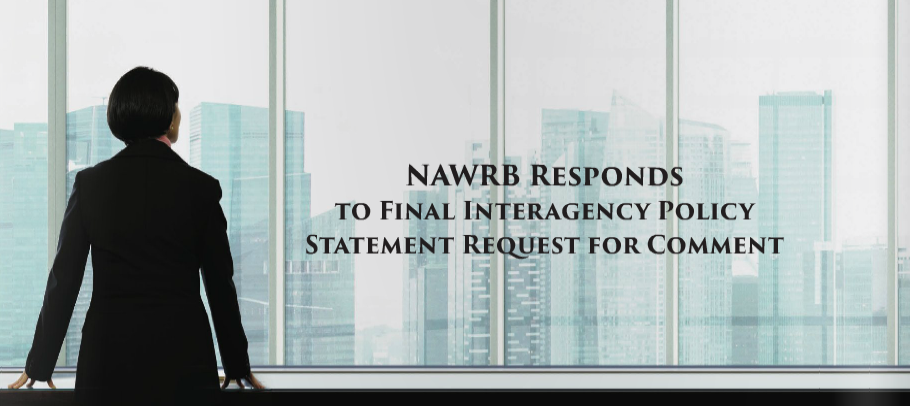Section 342 of the Dodd-Frank Wall Street Reform and Consumer Protection Act of 2010 mandated that federal agencies institute an Office of Minority and Women Inclusion (OMWI). The act distinguishes each OMWI as, “responsible for all matters of the agency relating to diversity in management, employment, and business activities.”
Furthermore, to determine the efficacy of each office, Dodd-Frank tasked OMWI directors with establishing diversity standards for agencies to assess the diversity policies and practices within the institutions they govern.
Of these agencies, six—the Federal Reserve Board (FRB), the Federal Deposit Insurance Corporation (FDIC), the National Credit Union Administration (NCUA), the Consumer Financial Protection Bureau (CFPB), the Office of the Comptroller of the Currency (OCC) and the Securities and Exchange Commission (SEC)—worked together to develop joint standards.
The six agencies also collaborated with the public, following the publication of a request for comments on the “Proposed Interagency Policy Statement Establishing Joint Standards for Assessing the Diversity Policies and Practices of Entities Regulated by the Agencies” in the Federal Register in October 2013.
The agencies issued a final statement establishing these standards in June 2015. Subdivided into five sections, this interagency policy statement addresses the barriers and difficulties burdening minorities and women today. To view the final statement in full please visit: https://www.fdic.gov/news/news/press/2015/pr15047a.pdf.
The agencies requested comments on the following topics concerning the proposed collection of information outlined in the final statement. The agencies will summarize the comments received and/or include them in their Office of Management and Budget (OMB) approval request. All comments will be a matter of public record.
1) Whether the collections of information are necessary for the proper performance of the agencies’ functions, including whether the information will have practical utility
2) The accuracy of the agencies’ estimate of the information collection burden, including the validity of the methods and the assumptions used
3) Ways to enhance the quality, utility, and clarity of the information proposed to be collected
4) Ways to minimize the information collection burden on respondents, including through the use of automated collection techniques or other forms of information technology
5) Estimates of capital or start-up costs and costs of operation, maintenance, and purchase of services to provide information
As an advocate for women and women-owned businesses, and a supporter of diversity and inclusion, NAWRB submitted a response to this request affirming the necessity of the collection of information and providing recommendations for the promotion of diversity. Our response and comment to the specific questions asked are summarized below.
Re: National Association of Women in Real Estate Businesses (NAWRB) Comments:
Final Interagency Policy Statement Establishing Joint Standards for Assessing the Diversity Policies and Practices of Entities Regulated By the Agencies and Request for Comment
Dear Ms. Cofield, Ms. Clark, Ms. Brooks, Ms. James, Mr. Ishimaru, and Ms. Gibbs,
Thank you for the opportunity to provide comments on the proposed collection of information outlined in the final interagency policy statement establishing the joint standards to meet the assessment requirements of Section 342(b)(2)(C) of the Dodd-Frank Wall Street Reform and Consumer Protection Act of 2010 (“Dodd-Frank Act”).
The National Association of Women in Real Estate Businesses (NAWRB) is the most visible women’s trade association specializing in the housing economy. NAWRB is dedicated to providing women the tools and opportunities for economic growth and expansion, while advocating and promoting women-owned businesses in housing. We are the only third-party industry-specific certifier of Women-Owned Businesses (WOB) and Minority Women-Owned Businesses (MWOB) in the housing economy.
NAWRB provides a unique platform for uniting Women in Housing and Women in Government including educational training on contracting opportunities, both government and private, to expand our members’ business growth.
NAWRB empowers women in our advocacy relationships with the Office(s) of Minority and Women Inclusion (OMWI), Government Sponsored Enterprises (GSE), the Small Business Administration (SBA), the National Women’s Business Council (NWBC) and other organizations. Since August of 2010, NAWRB has been championing the OMWIs, to bring more diversity and inclusion to our industry with their awareness, opportunities and access.
In regards to the standards and their enforcement, it is our belief that accountability is the most pertinent matter. With this in mind, NAWRB provides the following comments and recommendations:

1) Whether the collections of information are necessary for the proper performance of
the Agencies’ functions, including whether the information will have practical utility
Yes, the collection of information is necessary for the following reasons:
Accountability is paramount for the process of minority and women inclusion. If agencies do not have to disclose their diversity progress, how would failure or disregard be addressed and improved?
The information released by agencies will depict how seriously diversity initiatives are being regarded and how successful they are; this will allow agencies to determine whether their course of action towards minority and women inclusion has been successful or not, which will in turn instruct them on the best way to proceed.
The information disclosed will definitely have practical use because it will show the state of minority and women inclusion in the respective agencies and allow them to address shortcomings and successes. The information will also inform the public of the progress being made, and allow them to call for improvement where it is needed.
The publication of information will also help agencies compare progress and identify what methods have and have not worked, thereby allowing entities to adopt initiatives that have proven to be successful within other agencies.
Furthermore, accountability will be regarded with earnestness due to the exposure that the information will provide. Agencies that fail to genuinely promote diversity will be depicted as such, which will encourage them to improve their methods.

2) The accuracy of the Agencies’ estimate of the information collection burden, including the validity of the methods and the assumptions used
If entirely efficient, the estimated collection burden of 12 hours per regulated entity seems accurate. However, few processes are entirely efficient, and even simple procedures, such as uniting the entity members in charge of collecting and releasing this information may prove a tedious and lengthy task.
OMWI is a new office and the standards are very recent; even though the information would pertain to diversity policies and practices that are conducted during the normal course of business, the information and its collection will be new. Additionally, compiling the information together, in a clear and concise manner, and written explanations of what is being reported and published, may prove to take longer than 12 hours.
The task of deciding how to present the information, in what order or sections, discerning between what is relevant and what isn’t, will be a time consuming endeavor. The entities must be detailed in their information collection, making sure to address their actions, initiatives and practices and their results. Twelve hours seems a small amount of time for this undertaking.
Rather than estimate the burden hours for each agency and their entities, it would make sense to adopt a different process, such as a submittal window or deadline for the collection of this information. This way entities can address their collection of information process individually, according to their own circumstances and priorities.

3) Ways to enhance the quality, utility, and clarity of the information proposed to be collected
Detail is important; when releasing information, agencies must carefully detail the ways they are promoting diversity and the success and shortcomings of each of their efforts. The difficulty will be to always ensure that the minority and women inclusion is enforced. A matrix or scale, simply to determine progress and not for enforcement, would be ideal.
Explanations for the success of OMWI standards, as well as for their failure, must be addressed and submitted by each entity; there is a reason for successes and failures, and in a movement as important as diversity they must be identified.
The collected information should also be published in mainstream publications and media outlets. It would be a great disservice to release the information through a publication that the majority of the pubic is not familiar with and would not see. It is crucial that the public be aware of the diversity movement and of its state. Minority and women inclusion must not be a matter that is simply conducted internally, agencies and entities must be held accountable and the public is key.
A grading system could also prove beneficial to minority and women inclusion. It can be used to grade agencies on diversity, much like restaurants are judged on cleanliness. This, as with the publication of information, will hold agencies accountable and encourage minority and women inclusion processes. Additionally, a plus or minus sign next to the letter assigned to each agency could indicate an improvement or regression from the previous quarter.
Finally, the information provided must be analyzed and utilized in a manner that benefits minority and women inclusion. There is no use in collecting information if it will not be used. Whether diversity efforts are successful or not, the information regarding them must be reviewed in order to find what works and what doesn’t. The best way to increase the utility of the information collected is to utilize it.

4) Ways to minimize the information collection burden on respondents, including
through the use of automated collection techniques or other forms of information technology
Utilizing technology such as email and publishing the information strictly through the Internet could decrease the burden on entities; documents would not need to be printed or mailed and this would save a significant amount of time. Similarly, an electronic packet or survey could be created by the agencies or OMWIs so that each entity could simply complete and submit it, thereby creating uniformity in the publication of the information and saving entities the burden of deciding for themselves what information is relevant and important, and how to present it.
A system of collection other than an annual one could be put into practice, giving entities the freedom to collect and disclose information on their own time. This would make the process of collecting information more appealing and perhaps increase the entities that participate. However, this could also lead to entities disregarding the already voluntary process of collecting and publishing information, leading to the lack of information about OMWI success and the disregard of the office, its mission and its standards.

5) Estimates of capital or start-up costs and costs of operation, maintenance,
and purchase of services to provide information
The time burden of each agency multiplied by the salaries of the members chosen to collect and provide the information would yield an approximate estimate of costs. As each agency is different, costs will differ for each one.
If the collection were gathered electronically, no additional cost would accrue because entities already have equipment like computers; but if the collection of information were outsourced to an outside company then a significant cost would most likely accumulate.
NAWRB has been a strong supporter of OMWI since its inception in 2010. It is our belief that the progress being forged by the OMWIs is immense and beneficial for the American workplace. If a system ensuring the accountability of the agencies and the entities they govern is established, diversity and inclusion will continue to thrive in housing. It is up to you, the agencies, to ensure that this is done, for the good of the industry and our country.

To view the original article please see our magazine titled “Economic Growth” Vol 4, Issue 5 by Clicking Here

 Login
Login

